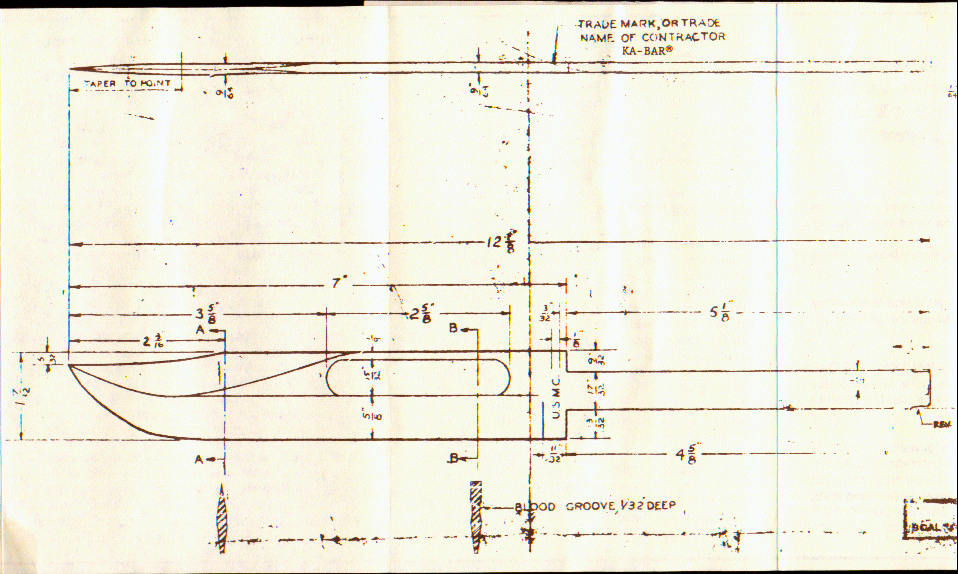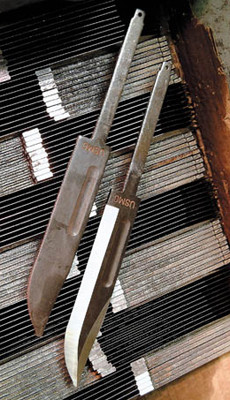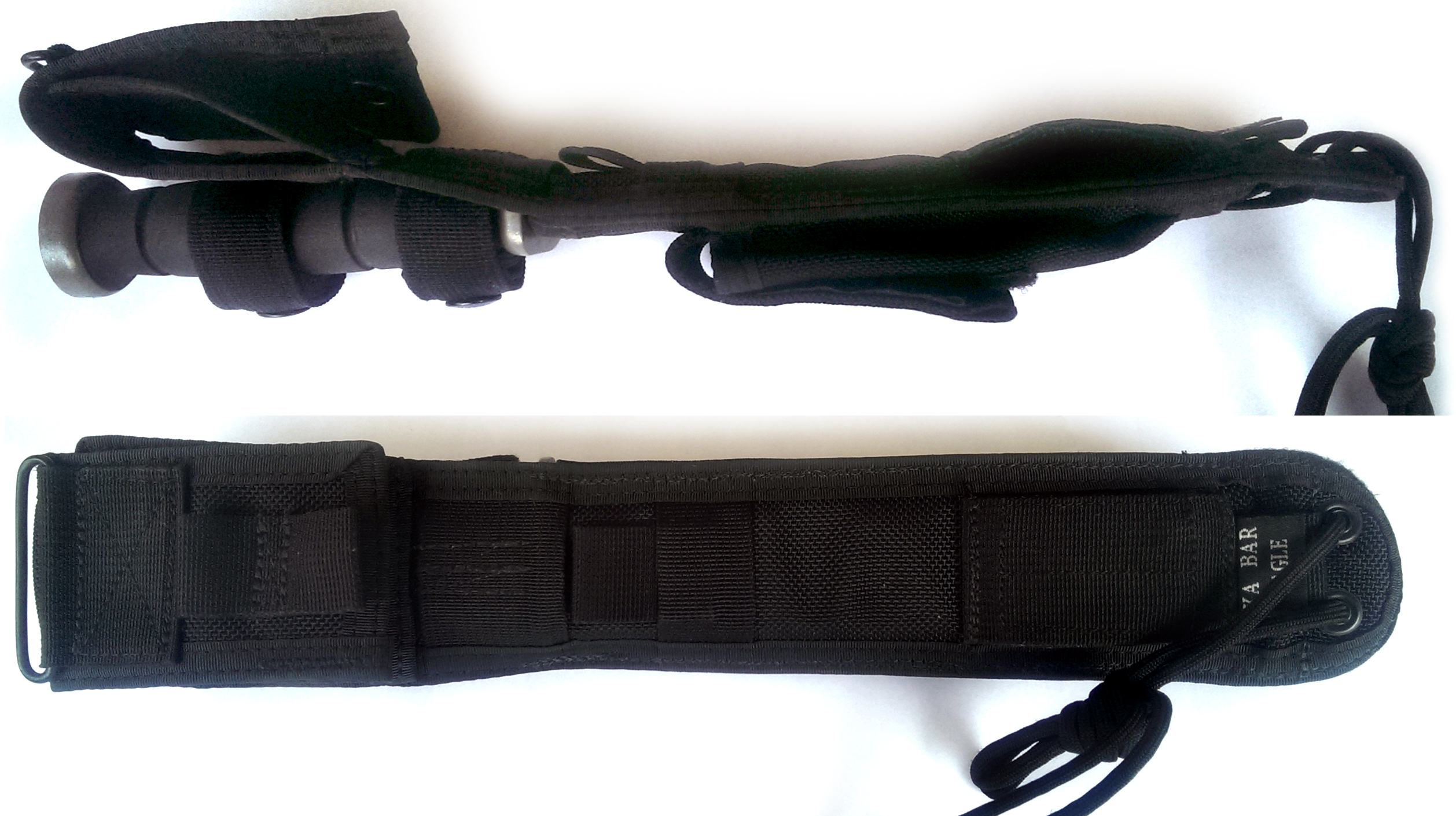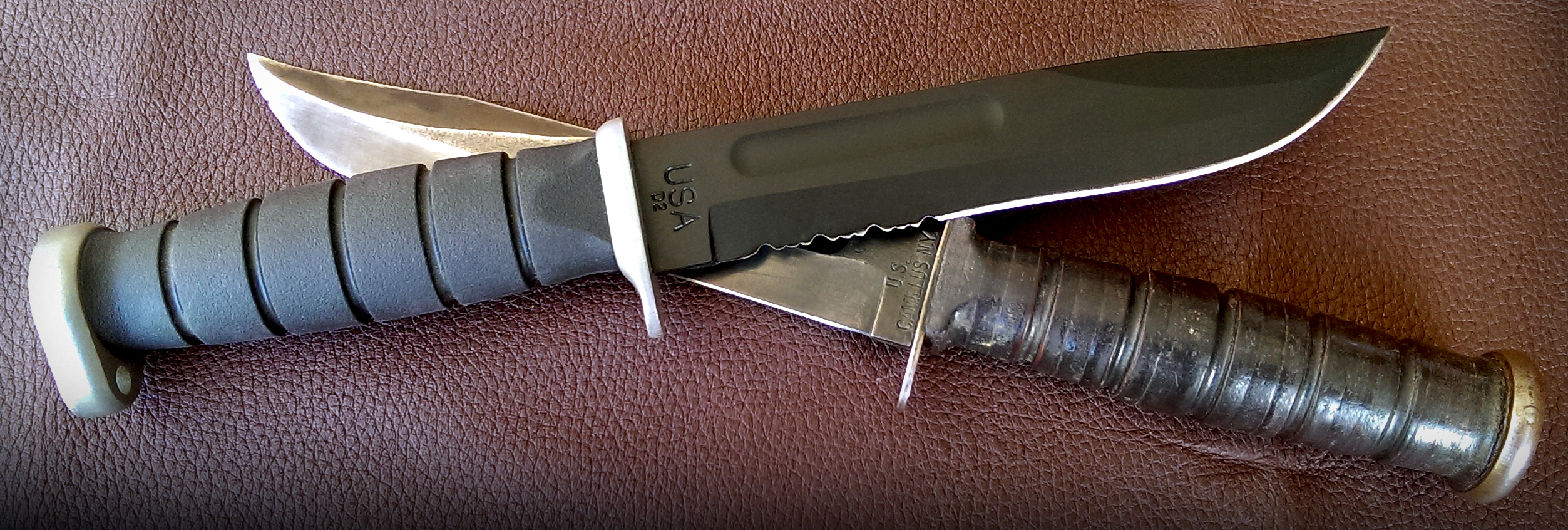This article was originally published on HROARR.com
When it comes to combat knives, next to the classical Fairbairn-Sykes Fighting Knife, few are as iconic as the USMC “KA-BAR”. However, while the Fairbairn-Sykes represents a more elegant design and delicate use, made specifically for surprise attacks, the KA-BAR is also a great utility knife that can be used not just for fighting, but also for a variety of chores when hiking or living outdoors. It is the role-model, the grand-daddy of many modern military and survival type knives used today. It has changed rather little over time, but in its most modern form it carries some distinct improvements which we will look closer at.
To really understand this knife, however, I strongly recommend you to have a look back at what came before it and what lies underneath its design. For this I have written an article entitled The KA-BAR and the Fairbairn-Sykes – Two fighting children of different philosophies which I suggest you read before continuing with this review.
The D2 Extreme Fighting/Utility Knife
So hoping you have now read the article mentioned above; over to the most modern version of this iconic knife. Although still maintaining the basic design of the original, some distinct changes have been made which I will comment more on later. The obvious changes are:
- A new, thicker finger guard, with the upper part removed
- A partially serrated blade
- An elongated pommel with a hole for adding a lanyard
- A rubber (Kraton G) grip instead of leather
- A powder-blackened, not blued blade like on the original
In addition to this other more subtle changes have also been made:
- Use of D2 tool steel that is hardened to 59-60CR
- A shorter beveling of the back of the blade
- A narrower fuller
- The rubber grip is now one-piece instead of stacked leather washers
- The grip is more distinctly oval in shape
And additionally, the Cordura sheath comes with a small and simple 34° Readi-Edge knife & fishing hook sharpener, although the knife can also be had with a glass-filled nylon or a leather sheath. The sharpener apparently wasn’t standard issue but carries the KA-BAR logo on it. Today, the knife and sheath is delivered without a sharpener.
The hard data for the knife can be summed up as:
| Weight | 0.75 lb / 353gr. | Steel | D2 |
| Blade Type | Fixed Blade | Lock Style | N/A |
| Measurements | Blade length 7″ / 17,9cm Overall length 11-7/8″ / 30,8cm |
Grind | Flat (Double Bevel) |
| Edge Angles | 20 Degrees | Handle Material | Kraton G® |
| Shape | Clip | HRC | 59-60CR |
| Stamp | KA-BAR | Butt Cap/Guard | Powdered Metal |
| Pocket Clip | N | Made in | Knife Made in USA, Sheaths As Noted |
| NSN | N/A | Blade Thickness | 0.165in / 4mm |
Hard data however, says little of what the actual knife is like and this is what we will be looking closer at now.
Grip & Hilt
The change in finger-guard design is welcome as this new design now means you can put your thumb on the top of the blade, something which has been commonly asked for and even customized by quite a few owners who have brutally removed it with a grinder.
The finger guard is almost twice as thick as on the original and rounded off inwards towards the index finger, which makes it quite comfortable. However, for stabbing at hard objects this also means a somewhat increased risk of having your fingers slide over the finger guard, not least since the upper guard of the original has been removed. Still, such extreme stabbing should be very rare. Just use it sensibly with this in mind and the risk should be minimal.
The pommel is no longer round & rounded off, but elongated & flat towards the back which both helps in pulling it loose when it has gotten stuck, but also provides a larger surface if you need to punch something with it. The pommel now also has a hole through which you can add a lanyard for added safety.
The finger guard and the pommel are both covered in matte gray coating. If you plan on using your knife for hammering, then you can expect the coating of the pommel to come off quite quickly, thus exposing the raw non-stainless steel.
The Kraton G grip provides excellent grip without feeling uncomfortable or causing blisters.
Blade & Tang
The medium length of the blade makes it quite versatile, while the thickness of it assures a decent strength. The shorter beveling of the back edge, which no longer extends over the fuller, should theoretically make it slightly stronger for batoning when splitting wood.

Old blueprint showing the blade and full hidden stick tang construction of an original KA-BAR. The blueprint shows beveling extending all the way over the fuller.
 The blade is partially serrated, something which I personally dislike as it just makes it more difficult to sharpen with no real benefit coming from the actual serrations, apart possibly from when there’s a need for e.g dismembering game and sawing through bone, for which purpose I would rather use something more appropriate or cut at the joints. Still, these serrations are of a “wavy” shape, more similar to what is seen on “Flamberge” swords, which makes it a fair compromise.
The blade is partially serrated, something which I personally dislike as it just makes it more difficult to sharpen with no real benefit coming from the actual serrations, apart possibly from when there’s a need for e.g dismembering game and sawing through bone, for which purpose I would rather use something more appropriate or cut at the joints. Still, these serrations are of a “wavy” shape, more similar to what is seen on “Flamberge” swords, which makes it a fair compromise.
The full hidden tang is of a “stick tang” design, but strong enough to take serious abuse. The tang is visible at the end of the pommel, just like on the original design, and the pommel is locked to the tang with a horisontal pin.
It should be noted that there is a common misconception that “stick tangs” always means a weak tang unsuitable for heavy use, but historically most bladed weapons have had this design and breakages were most common in the blade, not the tang. Other factors, like shaping of tang & blade, hardening & tempering and uniform grain structure are much more important.
Sheath / Scabbard
Today the sheaths for the KA-BAR knives are made in China, but when I bought mine they were still manufactured in the USA by Eagle. My comments here are therefore on the original Eagle sheath. The sheath is made out of very durable Cordura and it has a pocket for a field sharpener or fire steel, two holes for securing the sheath with a string to your thigh, as well as two buttoned straps to secure the knife with.

The Chinese make KA-BAR Cordura sheath
The sheath also has a good variety of holes, loops and buttons for securing it to different types of combat harnesses/tactical webbing and belts. I can’t tell for sure if it is fully Molle compatible, but it can be carried both horizontally and vertically and the many options should mean that it can be carried in almost any way desirable.

The side and back of the KA-BAR Eagle Cordura sheath showing the Velcro and the various loops. The belt loop has both a button and velcro for extra security
The sheath makes a small but noticeable click when you insert the knife into it and held upside-down the knife remains in the sheath but not if you shake it a little bit. So, always using the buttoned straps for securing it is required or you will risk losing your knife.
Handling
Returning to the previously described philosophies, this is a knife designed to do a lot of things well, but also nothing perfectly. Consequently, you will feel fairly comfortable doing most tasks with it as it has a sensible weight and is balanced well for its many purposes. But at the same time you will not feel that Wow-feeling you get from a knife designed perfectly for its purpose. It will serve you very well in most situations though. However, for gutting smaller game or fish, something else is to be preferred.

The D2 KA-BAR on top of my Korea War Camillus Mark 2 Combat Knife from 1961
The knife feels quite light and agile in hand, although not overly light. Comparing it to an Original Korea/Vietnam era, the D2 KA-BAR has a more distinct chopping presence. If that is a result from the 50 grams that it has gained or other changes in balancing I can’t say.
Like on the original, the grip is quite large, enough even for very big hands and there is at least 0.6in left of the grip when I hold the knife in a hammer grip with my normal-sized hands. I can quite comfortably hold it in a hammer, icepick or side-grip, as well as put my thumb on the grip against the finger guard. And with the removal of the finger guard on top of the knife, I can even thumb the back edge for further control when carving things.
The grip is now also more distinctly oval, which adds a bit more control when using the knife.
Maintenance & Durability
The blade on this particular knife is of a high-carbon, non-stainless steel called D2. It is blackened and covered in epoxy powder coating to prevent rust (and reflection). This means the knife can be given a very sharp and fairly strong edge at the cost of rust resistance. As a result you need to protect the fine edge carefully with oil, preferably a non-toxic oil if you plan to use it for preparation of food as well. The coating of the blade, finger-guard and pommel will of course also wear off with use and consequently yet more care will need to be taken.
The hardness of the D2 steel also theoretically means that it is a bit more brittle than some other types of steel. So while it can be sharpened to a very sharp edge, you also run a somewhat higher risk of chipping the edge if you strike stone, bone or steel and even breaking the blade under certain conditions. However, several people have been abusing them quite badly, stabbing and cutting at plate steel and cinder blocks without any bad experiences and testify to them being damn near indestructible.
With that said there have also been reports of knives breaking at the tang, but all those appear to be due to exaggerated abuse and use which the knife wasn’t really designed for, like (improper) batoning of wood or knife throwing and with improper use any tool will eventually break. A rare few freak samples appear to have passed their quality control though, but appear to have been duly replaced by the maker.
Personally I have experienced no issues with the knife, but I also use it sensibly, certainly for some quite demanding tasks, but not for knife throwing, digging up stones out of the ground or hacking down proper trees.
The knife comes sharpened with a double bevel grind, meaning the blade has two angles, with the edge sharpened at a 20° angle just like on the original Ka-Bar. This gives a fairly sharp edge while still offering good durability. As a comparison, a kitchen knife, or a typical Scandinavian knife comes sharpened at a 20-22°. The angle of the small included Readi-Edge sharpener is 34° which should provide a theoretically slightly sharper edge than the original included edge of 40°.
The hardness of the D2 steel gives you a very good edge retention, which means you won’t have to sharpen it as often. However, this also means you can only use a diamond or ceramic sharpener to sharpen the blade. Sharpening it against stone is impossible.
The non-stainless steel and the hardness of it makes for a strong and durable knife that requires careful maintenance. In my opinion that doesn’t make it ideal for use in environments where you have little opportunity or means for it. On the other hand, if you have the tools and time, then those same factors are a clear advantage, as the maintenance required is quite little.
Final comment and price
Philosophy-wise I believe in using the right tool for the job, so for chopping wood I would rather use an axe, for cutting down brush a machete and for fine bush chores; a knife with a really sharp, stainless 3.5-5 inch blade. With that said, I appreciate the philosophy of having one single, very versatile tool such as this too. Although it is unlikely for it to happen to most of us, a single tool for survival makes sense as it is easier to carry with you both before and during such an event. With that said, for most us, that is a bit of an exaggerated concern, I think.
Overall this is a very nice knife that fills its purpose well and is both well designed and manufactured. The only small changes I would personally like to see is a clean, non-serrated blade of stainless steel. Also the “Extreme” part of the name is a bit off-putting as it more seems to appeal to the teenage Zompoc and perceived macho aspects of the knife market, alongside of Turbo Jet Fighter Mach 17 safety razors etc.
Depending on what version of this knife & sheath you get and where you live, you can expect to pay anything from about 60-160€ excluding VAT and shipping. I have even seen some sell these for 350€ which is an over-price of near epic proportions. In the more sane price range though, it really is a great knife that is both practical, durable and even intimidating-looking, all features which can come in handy. And it looks pretty damn cool with its updated but timeless design. For us knife fetishists there is a clear emotional value in that too. It is part of what makes people love their knives, often bypassing all logic and reason.
***
Coming up we have several reviews of quite a few quality knives from companies that are military suppliers, like Fällkniven, Ontario, ESEE, Beltrame and Mora, as well as a few more unusual ones and even handmade knives by some very good cutlers/bladesmiths.




